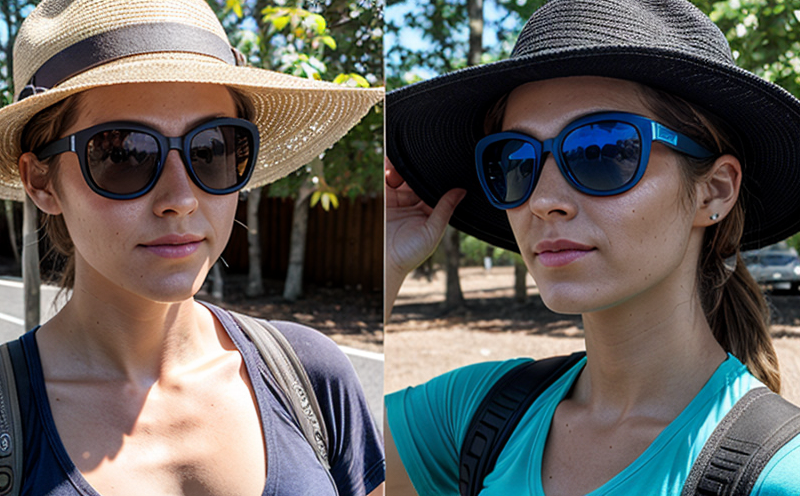ISO 9151 Protective clothing Determination of heat transfer under flame and UV exposure
The ISO 9151 standard is a critical protocol used to evaluate the protective performance of textiles, particularly in environments where workers are exposed to both flame and ultraviolet (UV) radiation. This service assesses the heat-transfer properties of fabrics under these conditions to ensure they meet safety standards for personal protective equipment (PPE).
The test aims at quantifying how quickly or slowly a fabric transfers heat when subjected to flame exposure, with UV factors further influencing the degradation and performance of the material over time. This is especially important in industries like manufacturing, construction, and fire services where workers are exposed to both thermal hazards and prolonged sunlight.
During testing, samples undergo controlled exposure to a flame source followed by a cooling period under specific conditions. The heat transfer rate is measured using thermocouples or similar devices placed at strategic points on the sample. Afterward, UV radiation is applied for extended periods to simulate real-world conditions. The test results help manufacturers and safety professionals determine if the fabric can withstand prolonged exposure without compromising its protective integrity.
The ISO 9151 standard ensures that protective clothing not only provides immediate protection against flame but also maintains its performance over extended use, especially under UV conditions which can degrade material properties. This service is pivotal for ensuring compliance with regulatory requirements and enhancing worker safety in high-risk environments.
| Key Parameters | Description |
|---|---|
| Flame Exposure Time | Duration of exposure to the flame source, controlled by ISO 9151. |
| Cooling Period Duration | The time allowed for the sample to cool after flame exposure. |
| UV Radiation Intensity | The level of UV light applied during testing, standardized for consistency. |
| Heat Transfer Measurement Method | Techniques used to measure heat transfer rates across the sample. |
- Thermocouples: Used to monitor temperature changes during and after exposure.
- Infrared Sensors: Provide additional data on thermal properties of the sample.
Why It Matters
The ISO 9151 standard is crucial for ensuring that protective clothing provides adequate protection in environments where both flame and UV exposure are significant risks. Flame hazards can occur suddenly, requiring immediate resistance to prevent burns, while prolonged UV exposure over time can degrade fabric integrity, reducing its effectiveness.
By adhering to this standard, textile manufacturers can ensure their products meet the highest safety standards, thereby safeguarding workers in high-risk industries. Compliance with ISO 9151 demonstrates a commitment to worker safety and regulatory adherence, which is essential for maintaining industry credibility and reputation.
This service supports various sectors including manufacturing, construction, fire services, and chemical processing where employees are frequently exposed to both thermal and UV stressors. Ensuring compliance helps reduce the risk of accidents, burns, and long-term health issues associated with prolonged exposure to these hazards.
Applied Standards
The ISO 9151 standard is part of a broader set of guidelines that ensure safety in personal protective equipment (PPE). It aligns closely with other standards such as EN 378, which covers flame resistance for textiles used in PPE. Together, these standards provide comprehensive protection against both thermal and UV hazards.
| Standard | Description |
|---|---|
| ISO 9151-1 | Determination of heat transfer under flame exposure. |
| ISO 9151-2 | Determination of heat transfer under UV exposure. |
| EN 378:2004 | Flame resistance of textiles used in PPE. |
The combination of these standards ensures that protective clothing meets stringent criteria for thermal and photothermal protection, providing the necessary level of safety for workers across various industries.
International Acceptance and Recognition
- Australia: The Australian Standard AS/NZS 1460.1:2009 incorporates ISO 9151 for flame resistance testing.
- New Zealand: The New Zealand Standard NZS 1460.1:2013 aligns with ISO 9151 in its approach to PPE flame protection.
- United States: ASTM F1357, which is internationally recognized, covers similar aspects of thermal protective performance but focuses more on overall burn protection than specific heat transfer under UV exposure.
- European Union: The EU harmonizes its PPE regulations with ISO standards, including those for flame and UV resistance. EN 378 is widely accepted as a supplement to the broader PPE directive.
- Singapore: Singapore's Industrial Safety Regulations reference ISO standards in their guidelines for PPE.
The widespread adoption of these international standards ensures that protective clothing manufacturers and users can rely on consistent, high-quality protection across global markets. Compliance with these standards is a testament to the commitment to worker safety and regulatory compliance worldwide.





